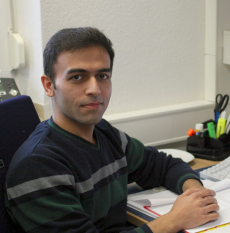Education
- Since 2019:
PhD in the Institute of Bioinformatics, Faculty of Medicine, University of Münster, Germany
- 2017 - 2019:
pre-doctoral fellow in the Institute of Bioinformatics, Faculty of Medicine, University of Münster, Germany
Work Experience
- 2009 - 2016:
Lecturer and Director of the Genetics Laboratory, Tehran Institute of Technology - Branch of Sabzevar, Iran
Supervisors
- Prof. Dr. Wojciech Makałowski, Institute of Bioinformatics, University of Münster, Germany
- Prof. Dr. Jürgen Rudolf Gadau, Institute for Evolution and Biodiversity, University of Münster, Germany
- PD Dr. Jürgen Schmitz, Institute of Experimental Pathology, University of Münster, Germany
Research interests
- Medical genomics
- Single-cell multimodal informatics
- Detection of somatic structural variants using single-molecule sequencing data
- Immunoinformatics
- Epigenomics
- Clonal evolution analysis in cancer
- Systems biology
- Computational biology
PhD project description
Comprehensive study of transposon-driven transductions in cancer and healthy genomes
Mobile element insertions (MEIs) constitute about 25 percent of the human structural variants. They are three different transposable element (TE) families that are presently active in the humans: Ll elements of the LINE order and two types of SINEs, i.e. Alu and SVA. While the Ll element is autonomous, the latter depends on Ll molecular machinery to move around the genome. Consequently, all three elements share similar transposition signatures: the Target Site Duplications (TSDs), polyA tracks, frequent 5' inversions due to twin priming, 5' truncations caused by incomplete replication, and 3'-transductions as a result of using alternative, downstream poly(A) signals. The latter is especially interesting from the evolutionary point of view because as hypothesized two decades ago it may be a source of genome shuffling. There is a plenty of evidence that MEIs lead to human diseases, such as gyrate atrophy, hemophilia b, neurofibromatosis, cystic fibrosis, cancers, and many others.
The recent development of sequencing technologies resulted in thousands of human genomes available for the analysis. Although sequenced at the different coverage level and usually limited to short reads, the available data enable MEI studies at the population level. I will investigate thousands of publicly available genomes of both normal and disease phenotypes. Thanks to my supervisor’s involvement in several large-scale genomic projects I will also have access to yet-unreleased data. The ultimate goal of the project will be to understand population dynamics of MEJs, with the special focus on DNA transduction and their evolutionary consequences. I also hope to be able to evaluate their roles in driving human diseases, especially different type of cancer.
Publications
- Arang Rhie, Sergey Nurk, Monika Cechova, Savannah J. Hoyt, Dylan J. Taylor, Nicolas Altemose, Paul W. Hook, Sergey Koren, Mikko Rautiainen, Ivan A. Alexandrov, Jamie Allen, Mobin Asri, Andrey V. Bzikadze, Nae-Chyun Chen, Chen-Shan Chin, Mark Diekhans, Paul Flicek, Giulio Formenti, Arkarachai Fungtammasan, Carlos Garcia Giron, Erik Garrison, Ariel Gershman, Jennifer L. Gerton, Patrick G. S. Grady, Andrea Guarracino, Leanne Haggerty, Reza Halabian, Nancy F. Hansen, Robert Harris, Gabrielle A. Hartley, William T. Harvey, Marina Haukness, Jakob Heinz, Thibaut Hourlier, Robert M. Hubley, Sarah E. Hunt, Stephen Hwang, Miten Jain, Rupesh K. Kesharwani, Alexandra P. Lewis, Heng Li, Glennis A. Logsdon, Julian K. Lucas, Wojciech Makalowski, Christopher Markovic, Fergal J. Martin, Ann M. Mc Cartney, Rajiv C. McCoy, Jennifer McDaniel, Brandy M. McNulty, Paul Medvedev, Alla Mikheenko, Katherine M. Munson, Terence D. Murphy, Hugh E. Olsen, Nathan D. Olson, Luis F. Paulin, David Porubsky, Tamara Potapova, Fedor Ryabov, Steven L. Salzberg, Michael E. G. Sauria, Fritz J. Sedlazeck, Kishwar Shafin, Valery A. Shepelev, Alaina Shumate, Jessica M. Storer, Likhitha Surapaneni, Angela M. Taravella Oill, Françoise Thibaud-Nissen, Winston Timp, Marta Tomaszkiewicz, Mitchell R. Vollger, Brian P. Walenz, Allison C. Watwood, Matthias H. Weissensteiner, Aaron M. Wenger, Melissa A. Wilson, Samantha Zarate, Yiming Zhu, Justin M. Zook, Evan E. Eichler, Rachel J. O’Neill, Michael C. Schatz, Karen H. Miga, Kateryna D. Makova & Adam M. Phillippy (2023) The complete sequence of a human Y chromosome. Nature 621, 344–354 10.1038/s41586-023-06457-y [doi]
- Halabian R, Makałowski W (2022) A map of 3' DNA transduction variants mediated by non-LTR retroelements on 3202 human genomes. Biology 11(7):1032. 10.3390/biology11071032 [doi]
- Hoyt SJ, Storer JM, Hartley GA, Grady PGS, Gershman A, de Lima LG, Limouse C, Halabian R, Wojenski L, Rodriguez M, Altemose N, Rhie A, Core LJ, Gerton JL, Makalowski W, Olson D, Rosen J, Smit AFA, Straight AF, Vollger MR, Wheeler TJ, Schatz MC, Eichler EE, Phillippy AM, Timp W, Miga KH, O'Neill RJ (2022) From telomere to telomere: The transcriptional and epigenetic state of human repeat elements. Science 376(6588):eabk3112. 10.1126/science.abk3112 [doi]
- Bohn J, Halabian R, Schrader L, Shabardina V, Steffen R, Suzuki Y, Ernst UR, Gadau J, Makalowski W (2021) Genome assembly and annotation of the California harvester ant Pogonomyrmex californicus. G3 11(1):jkaa019. 10.1093/g3journal/jkaa019 [doi]
Memberships
- February 2022- present: Member of the international society for computational biology (iSCB).
- March 2021- present: Member of the Telomere-to-Telomere (T2T) human genome consortium.
